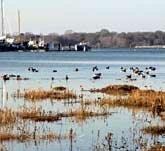
Life Cycle...
Find out more about the Greenshanks of Chichester and Langstone harbours: what do they eat, where do they migrate to and where do they breed?

Find out more about the Greenshanks of Chichester and Langstone harbours: what do they eat, where do they migrate to and where do they breed?
The Greenshanks that use Chichester and Langstone harbours are part of the population that breed in Scandinavia and eastwards into Russia. At least, we think they do - we hope to find out more during the project. They travel southwards and westwards for the winter, and can be found across the UK around inland lakes and freshwater marshes and at coastal wetlands and estuaries during migration. In winter Greenshank are almost purely an estuarine species in the UK.
Greenshanks use sites along the North Sea, English Channel and North Atlantic coastlines as staging posts on autumn migration and in early winter, with some remaining to over-winter. Ringing recoveries and colour-ring sightings suggest a more dispersed spring migration with many Greenshanks migrating from Africa via the western Mediterranean and inland Europe, back to Scandinavia and western Russia. Birds colour-ringed in Chichester and Langstone harbours have been sighted in spring in Corsica, western Italy, on the Rhine in Germany and central Spain.
In coastal areas, Greenshanks spend low tide periods feeding in shallow pools, often high on the mudflats, and in creeks. They dash about chasing small fish and crustaceans in pools and shallow channels. When hunting, Greenshanks often walk quickly with their bills in the sediment, disturbing prey that can then be chased. In freshwater environments they eat insects, worms, small fish and even small frogs.
A Greenshank on the coast can only feed when the tide is out and small pools and creeks are available for fishing. The timing of this varies from day to day with the tides. If low tide occurs at night, prey can be detected by touch, although we think they also have very good eyesight and can feed visually during the day (Peter potts). Washing and drinking are also important, so a Greenshank will find a small pool, or a little stream flowing out from the land. When the tide comes in it is time to roost, so birds go to areas of higher ground nearby where they can feel secure. This can be on the shore, or on fields, rocks and riverbanks nearby. As Greenshanks arrive at a roost site they usually wash and preen before they settle down to roost over the high tide period. Just before they leave the roost this behaviour may be repeated (based on observation of roosts in Chichester and Langstone harbours).
Greenshanks usually nest on dry ground in marshy areas or wet grassland, often near trees or other features that can be used as vantage points. The nest itself is a scrape in the ground hidden in vegetation or by rocks. Greenshanks use the same nest site for many years. Four eggs are laid, and are incubated for 24 days. Both parents share incubation and care for the chicks, which are able to feed themselves. Adults tend to migrate before the juveniles. It is thought that many females migrate ahead of the males, leaving them to take care of the chicks. We will be investigating this as part of the project.
Greenshanks are on passage through southern Britain in autumn. Information suggests that Greenshank breeding in northeast Europe leave the breeding grounds from July through to September and slowly travel south and west to winter in south-western Europe and North Africa. Many of these birds pass through Britain and probably Ireland in the autumn. Greenshanks are found in the Solent largely in the autumn, although there is a small wintering population. Colour-ring recoveries suggest that these birds may be part of the Scandinavian breeding population, and there is some evidence that these birds may stop off elsewhere around the North Sea before arriving in the Solent. After leaving the Solent some birds move to southwest Britain while most migrate to West Africa. The peak spring migration through the Solent is in late April/early May, although colour-ring sightings from continental Europe and eastern England suggest that the return migration of Solent birds follows a more easterly route.
Greenshanks from the Scottish breeding population return to their breeding grounds in late March and depart from mid-June through to August. This is earlier than more eastern populations, as it takes longer for breeding sites in Scandinavia and western Russia and Siberia to thaw. The female usually leaves later, in June or early July, often before the young have fledged. The male remains with the brood and cares for the young through July. The juveniles generally leave for the wintering grounds last. There is limited information about the movements of the Scottish breeding population due to the lack of ringing recoveries, but it is thought these birds winter in Ireland and western Britain, as well as southwest Europe and northern Africa.
Much of this information on migration comes from the Migration Atlas, 2002. You can find out more in the Migration Story section of this project.
The two harbours form one unit as their Greenshank populations are closely linked. Autumn is the best time to see Greenshanks in the harbours. Numbers begin to increase in July, and reach their peak in August or September. There are still good numbers in October, but from November through the winter only a few remain. Until recently it was unusual to see any Greenshank in winter; we think that milder winters are encouraging them to stay.